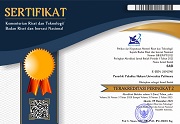The Application of the Burden of Proof Concept in Indonesia: A Comparative Study
 )
)
(1) Faculty of Sharia Institut Agama Islam Negeri Lhokseumawe, Lhokseumawe, Indonesia
(2) Faculty of Law Malikussaleh University, Lhokseumawe, Indonesia
 Corresponding Author
Corresponding Author
Abstract
Introduction: One of the reasons for a reverse proof system is the difficulty of proving the offenses committed by certain perpetrators of a criminal offense, such as corruption and money laundering. Thus, the government issues the legal policy to apply a reverse burden of proof to solve this problem.
Purposes of the Research: This study aims to analyze the application of the reverse burden of proof in Indonesian and Islamic criminal law.
Methods of the Research: This research is legalistic, doctrinal, or normative, using a comparative law approach to compare the application of a reverse burden of proof in Indonesian criminal law and Islamic criminal law.
Results of the Research: The application of a reverse burden of proof in Indonesia is limited and balanced (balanced probability of principles) as regulated in Article 37 of Law no. 31 of 2019 in conjuction with Law No. 20 of 2000 concerning the Eradication of Corruption Crimes and Article 35 of Law no. 8 of 2010 concerning the Prevention and Eradication of the Crime of Money Laundering. In Islamic criminal law, the application of t a reverse burden of proof has long been carried out, as seen in Surah Al-Nisa verse 135 and the story of Prophet Yusuf's proof of Zulaikha's accusation in Surah Yusuf verses 24-29, and several hadiths of the Prophet Muhammad. These two legal systems are similar in terms of the application of a reverse burden of proof that is only applied to certain cases, such as corruption and money laundering. However, the difference is that the application of a reverse burden of proof in Indonesian criminal law is limited and balanced. In contrast, the principle of a reverse burden of proof against corruption cases in Islamic criminal law is absolute.
Keywords
DOI
10.47268/sasi.v28i3.1045
Published
2022-10-13
How To Cite
@article{SASI1045,
author = {Abdullah Abdullah and Muhammad Hatta},
title = {The Application of the Burden of Proof Concept in Indonesia: A Comparative Study},
journal = {SASI},
volume = {28},
number = {3},
year = {2022},
keywords = {Application; Draft; Burden; Proof; Reverse; Indonesia; Comparative Study},
abstract = {Introduction: One of the reasons for a reverse proof system is the difficulty of proving the offenses committed by certain perpetrators of a criminal offense, such as corruption and money laundering. Thus, the government issues the legal policy to apply a reverse burden of proof to solve this problem.Purposes of the Research: This study aims to analyze the application of the reverse burden of proof in Indonesian and Islamic criminal law.Methods of the Research: This research is legalistic, doctrinal, or normative, using a comparative law approach to compare the application of a reverse burden of proof in Indonesian criminal law and Islamic criminal law.Results of the Research: The application of a reverse burden of proof in Indonesia is limited and balanced (balanced probability of principles) as regulated in Article 37 of Law no. 31 of 2019 in conjuction with Law No. 20 of 2000 concerning the Eradication of Corruption Crimes and Article 35 of Law no. 8 of 2010 concerning the Prevention and Eradication of the Crime of Money Laundering. In Islamic criminal law, the application of t a reverse burden of proof has long been carried out, as seen in Surah Al-Nisa verse 135 and the story of Prophet Yusuf's proof of Zulaikha's accusation in Surah Yusuf verses 24-29, and several hadiths of the Prophet Muhammad. These two legal systems are similar in terms of the application of a reverse burden of proof that is only applied to certain cases, such as corruption and money laundering. However, the difference is that the application of a reverse burden of proof in Indonesian criminal law is limited and balanced. In contrast, the principle of a reverse burden of proof against corruption cases in Islamic criminal law is absolute.},
issn = {2614-2961}, pages = {458--469} doi = {10.47268/sasi.v28i3.1045},
url = {https://fhukum.unpatti.ac.id/jurnal/sasi/article/view/1045}
}
Journal Article
Adji, Indriyanto Seno. “Perspektif Perbuatan Melawan Hukum Terhadap Tindak Pidana Korupsi.” Jurnal Hukum Pro Justitia 25, no. 4 (2007): 283–304. https://doi.org/10.20885/jhpj.vo25.iss4.art6.
Analiansyah. “Hukum Pembuktian Terbalik Dalam Perspektif Hukum Islam.” Jurnal Al-Murshalah 2, no. 1 (2016): 38–52. https://doi.org/10.18196/jam.vo2.i1.217.
Eddyono, Supriyadi Widodo. “Verification Reversed Imposition And It’s Challenges.” Legislasi Indonesia 8, no. 2 (2013): 267–80. https://doi.org/10.54629/jli.v8i2.358.
Hart, Hamilton. “Anti Corruption Strategies in Indonesia.” Buletin of Indonesia Economic Studies 37, no. 1 (2001): 65–88. https://doi.org/10.1080/000749101300046519.
Hashim, Ashraf Bin Md. “Tahap Pembuktian Di Dalam Kes-Kes Jenayah: Kajian Perbandingan Antara Undang-Undang Islam Dan Sivil.” Jumal Syariah 9, no. 2 (2001): 13-32. https://doi.org/10.22452.
Hatta, Muhammad. Kejahatan Luar Biasa: Extra Ordinary Crime. Unimal Press. Vol. 1, 2019. https://doi.org/10.1017/CBO9781107415324.004.
Munawar, Kukun Abdul Syakur. “Pembuktian Terbalik Sebagai Kebijakan Kriminal Dalam Penanganan Tindak Pidana Korupsi.” Jurnal Hukum 5, no. 2 (2017): 224–45. http://dx.doi.org/10.25157/jigj.v5i2.820.
Noor, Ruzman, and Istajib Mokhtar. “Ulasan Kes Dari Aspek Pembuktian: Rosmah Binti Suly & Seorang Yang Lain Lwn. Ismail Bin Mohamad & Seorang Yang Lain [JH 32/2, JUN 2011, 223].” Jurnal Kanun 26, no. 1 (2015). http://dx.doi.org/10.30821/kanun.v26i1.121.
Nugroho, Bastianto. “Peranan Alat Bukti Dalam Perkara Pidana Dalam Putusan Hakim Menurut KUHAP.” Yuridika 32, no. 1 (2017): 21-25. https://doi.org/10.20473/ydk.v32i1.4780 .
Paul, Augustine. “Evidence-Practice and Procedure.” Malayan Law Journal 5 (2003): 540.
Rahman, Gazali. “Asas Pembuktian Terbalik Dalam Tindak Pidana Korupsi (Perspektif Hukum Pidana Indonesia Dan Hukum Pidana Islam).” Tahkim: Jurnal Hukum Dan Syariah XV, no. 2 (2019): 235–45. http://dx.doi.org/10.33477/thk.v15i2.2702.
Shariff, Ahmad ‘Azam Mohd. “Syariah Prosecution Procedure: Analysis on Legal Provisions under Syariah Criminal Procedure (Federal Territories) Act 1997 and Syariah Criminal Courts (Federal Territories) Act 1997.” Jurnal Undang-Undang & Masyarakat 15 (2011): 1–18.
Yaqin, A. “Legal Research and Writting.” Malayan Law Journal SDN BHD 1 (2007): 10.
Book
Adji, Indriyanto Seno. Korupsi Dan Permasalahannya. Jakarta: Diadit Media Press, 2012.
Al-Zarqa, Mustafa Ahmad. Al-Madkhal Al-Fiqhi Al-‘Am. II. Beirut: Matba’ah Tharban, 1986.
Anshoruddin. Hukum Pembuktian Menurut Hukum Acara Islam Dan Hukum Positif. Yogyakarta: Pustaka Pelajar, 2014.
Byrne, J. A Gabbo David. Cross on Evidence. Singapore: Tien Wah Press, 1980.
Cees, Schaap. Fighting Money Laundering. London: Kluwer Law International, 1998.
Diantha, I Made Pasek. Metodologi Penelitian Hukum Normatif Dalam Justifikasi Teori Hukum. Jakarta: Prenanda Media Group, 2017.
Effendy, Marwan. Sistem Peradilan Pidana Tinjauan Terhadap Beberapa Perkembangan Hukuh Pidana. Jakarta: Referensi Jakarta, 2012.
Groeschel, Hayt. Law of Hospital, Physician and Patient. Physician`s Record Company: Berwyn, 1972.
Hiariej, E. O. S. Pembuktian Terbalik Dalam Pengembalian Aset Kejahatan Korupsi. Yogyakarta: Universitas Gadjah Mada, 2012.
Hidma, TR. Pitlo Het Nederlands Burgerlijk Recht Deel 7 Bewijs Achtste Druk. Kluwer: Deventer, 2004.
Ibrahim, Hamid. Law of Evidence. Kuala Lumpur: Central Law Book Corporation Sdn. Bhd, 1993.
Kasim, Shopian. Money Laundering Dan Pembuktian Terbalik. Jakarta: Republika, 1998.
Lumbun, T. Gayus. Menerobos Goa Hantu Peradilan Indonesia. Jakarta: Busines Information Service (BIS), 2004.
Majelis Ulama Indonesia. Himpunan Fatwa Majelis Ulama Indonesia Sejak 1975. Jakarta: Erlangga, 2011.
Nor, Siti Zalikhah Haji Md. Beberapa Aspek Dalam Undang-Undang Keterangan Islam. 3rd ed. Kuala Lumpur: Dewan Bahasa dan Pustaka, 2006.
Prints, Darwan. Hukum Acara Pidana Dalam Praktik. Jakarta: Djambatan, 1998.
Prodjohamidjojo, Martiman. Komentar Atas KUHAP: Kitab Undang-Undang Hukum Acara Pidana. Jakarta: Pradnya Paramitha, 1984.
Purnomo, Bambang. Pokok-Pokok Tata Cara Peradilan Indonesia. Jogjakarta: Liberti, 2004.
Saad, Zulfakar Ramlee. Pembuktian Dalam Kes Jenayah Syariah Malaysia: Isu Dan Penyelesaian (Proving Cases in Syariah Courts: Issues and Resolutions). Kuala Lumpur: Dewan Bahasa dan Pustaka, 2008.
Yazid, Abu. Fiqh Realitas. Yogyakarta: Pustaka Pelajar, 2015.
| Dublin Core | PKP Metadata Items | Metadata for this Document | |
| 1. | Title | Title of document | The Application of the Burden of Proof Concept in Indonesia: A Comparative Study |
| 2. | Creator | Author's name, affiliation, country | Abdullah Abdullah; Faculty of Sharia Institut Agama Islam Negeri Lhokseumawe, Lhokseumawe; Indonesia |
| 2. | Creator | Author's name, affiliation, country | Muhammad Hatta; Faculty of Law Malikussaleh University, Lhokseumawe; Indonesia |
| 3. | Subject | Discipline(s) | |
| 3. | Subject | Keyword(s) | Application; Draft; Burden; Proof; Reverse; Indonesia; Comparative Study |
| 4. | Description | Abstract | Introduction: One of the reasons for a reverse proof system is the difficulty of proving the offenses committed by certain perpetrators of a criminal offense, such as corruption and money laundering. Thus, the government issues the legal policy to apply a reverse burden of proof to solve this problem.Purposes of the Research: This study aims to analyze the application of the reverse burden of proof in Indonesian and Islamic criminal law.Methods of the Research: This research is legalistic, doctrinal, or normative, using a comparative law approach to compare the application of a reverse burden of proof in Indonesian criminal law and Islamic criminal law.Results of the Research: The application of a reverse burden of proof in Indonesia is limited and balanced (balanced probability of principles) as regulated in Article 37 of Law no. 31 of 2019 in conjuction with Law No. 20 of 2000 concerning the Eradication of Corruption Crimes and Article 35 of Law no. 8 of 2010 concerning the Prevention and Eradication of the Crime of Money Laundering. In Islamic criminal law, the application of t a reverse burden of proof has long been carried out, as seen in Surah Al-Nisa verse 135 and the story of Prophet Yusuf's proof of Zulaikha's accusation in Surah Yusuf verses 24-29, and several hadiths of the Prophet Muhammad. These two legal systems are similar in terms of the application of a reverse burden of proof that is only applied to certain cases, such as corruption and money laundering. However, the difference is that the application of a reverse burden of proof in Indonesian criminal law is limited and balanced. In contrast, the principle of a reverse burden of proof against corruption cases in Islamic criminal law is absolute. |
| 5. | Publisher | Organizing agency, location | Faculty of Law, Universitas Pattimura |
| 6. | Contributor | Sponsor(s) | Faculty of Sharia Institut Agama Islam Negeri Lhokseumawe, Lhokseumawe; Faculty of Law Malikussaleh University, Lhokseumawe |
| 7. | Date | (YYYY-MM-DD) | 2022-10-13 |
| 8. | Type | Status & genre | Peer-reviewed Article |
| 8. | Type | Type | |
| 9. | Format | File format | |
| 10. | Identifier | Uniform Resource Identifier | https://fhukum.unpatti.ac.id/jurnal/sasi/article/view/1045 |
| 10. | Identifier | Digital Object Identifier | 10.47268/sasi.v28i3.1045 |
| 11. | Source | Title; vol., no. (year) | SASI; Volume 28 Issue 3, September 2022 |
| 12. | Language | English=en | en |
| 13. | Relation | Supp. Files |
The Application of the Burden of Proof Concept in Indonesia: A Comparative Study (122KB) The Application of the Burden of Proof Concept in Indonesia: A Comparative Study (122KB) |
| 14. | Coverage | Geo-spatial location, chronological period, research sample (gender, age, etc.) | |
| 15. | Rights | Copyright and permissions | Copyright: Authors who publish their manuscripts in this Journal agree to the following conditions: 1. The copyright in each article belongs to the author, as well as the right to patent. 2. Authors can enter into separate, additional contractual arrangements for the non-exclusive distribution of the journal's published version of the work (e.g., post it to an institutional repository or publish it in a book), with an acknowledgment of its initial publication in this journal. 3. Authors are permitted and encouraged to post their work online (e.g., in institutional repositories or on their website) before and during the submission process, as it can lead to productive exchanges, as well as earlier and greater citation of published work. 4. Authors have the right to self-archiving of the article (Author Self-Archiving Policy)
License: The SASI Journal is disseminated based on the Creative Commons Attribution-NonCommercial 4.0 International license terms. This license allows anyone to copy and redistribute this material in any form or format, compose, modify, and make derivatives of this material for any purpose. You cannot use this material for commercial purposes. You must specify an appropriate name, include a link to the license, and certify that any changes have been made. You can do this in a way that is appropriate but does not imply that the licensor supports you or your use.
|
Copyright (c) 2022 Abdullah Abdullah, Muhammad Hatta

This work is licensed under a Creative Commons Attribution-NonCommercial 4.0 International License.

 : 3718 times
: 3718 times Download : 2045 times
Download : 2045 times
















